St Giles
Day Open Air School
Featherbed Lane, Addington, CR0 9AW
Medical
dates:
Medical
character:
Open Air School
Croydon was one of the tardier
education authorities to embrace the open air schools movement.
St Giles Day Open Air School was the only such school set up
for the town and its surrounding areas. This may
reflect the outer suburban environment, as educational facilities
for the physically disabled were often given priority over those
for
'delicate' children (a condition regarded mainly as a problem of the
slums of London).
Nevertheless, in December 1923, the local School Medical Officers recommended that an open air school be established for 50 children. It was to be set up in the grounds of the existing Winterbourne Road Schools complex in Thornton Heath, next to the Infants School. It was intended that the Open Air School would form part of a unit also supporting physically defective children. As it turned out, the latter took priority and, on 19th January 1925, Winterbourne Road School - a physically defective day school - opened.
The School was housed temporarily in wooden huts moved from the grounds of the nearby Ecclesbourne Road School. (These huts were probably left over from wartime use of that school as part of the Croydon War Hospital.)
The School had a cloakroom and two classrooms with an open verandah on the south side. Its pupils included the crippled and those with enlarged glands or cardiovascular problems. A local firm, Theale Bros, provided a two-horse ambulance to collect the children and convey them to the School, returning them home at the end of the day. In September 1926 this vehicle was replaced by a motor ambulance.
While the School catered for physically challenged children rather than the delicate, much of the open air philosophy was observed. As well as more standard classes, the curriculum included 'Assembly and Recitation', 'Needlework or Gardening', 'Drawing or Dancing' and 'Observations'. School work included physical exercises, a variety of handwork, domestic work in the kitchens and cleaning skills, e.g. for brasswork.
Each term the children were medically examined. The School had its own clinic for minor ailments; remedial exercises and massage were also provided. For more serious matters, there was an orthopaedic referral service.
After three years the Medical Branch of the Board of Education approved the plans from the Croydon Local Education Authority to open a day open air school facility explicitly for delicate children. To accommodate the delicate children, the school roll was increased from 44 to 60 and, by September 1928, the Winterbourne Road School was being referred to as the St Giles Physically Defective Council School.
By 1931, however, it was becoming evident that the existing site was inadequate. The School was overcrowded, with 77 pupils and a waiting list. There was no common school hall and, to serve the midday meal, all the classroom desks had to be moved about. Nor were there any post-lunch rest facilities - particularly important for the pupils with cardiac conditions. The playground space was already very limited - little or no expansion was possible - and using up play space would, in any case, have degraded the children's physical well-being.
It was decided to move the School to a new 6.5-acre (2.5 ha) site in Featherbed Lane, near Addington, formerly part of a golf course.
The new St Giles Special School opened on 8th March 1933 in purpose-built buildings, again designed primarily for physically defective children, but with a further intention to increase the number of delicate children to 75.
The new school consisted of an administration block, a lavatories block, two classrooms (of the open air type) on the south side, a special subject room and a dining room, all connected by covered walkways. Future plans included a large sleeping shed with open sides.
By 1934 the school garden had been planted up and a beehive installed in the school orchard.
During the 1930s the School was affected several times by infections, resulting either in low attendance or temporary closure due to measles, influenza and (in November 1936) diphtheria. The autumn of 1937 must have been particularly fraught; a typhoid fever epidemic claimed the lives of dozens of people in Croydon. Its source was traced back to Addington Well, which was next to the School.
After a four year delay, the extension for delicate children finally opened in 1937. The first pupils were admitted on 18th October, and more the following April. By this time, the school roll allowed up to 190 pupils, of whom no more than 85 were to be cripples.
From then on, it was decreed, the school would be known as the Croydon St Giles Day Open Air Council School, receiving pupils from Croydon and surrounding districts, from as far as Redhill in the south.
The outbreak of war in 1939 resulted in the closure of many open air schools or their evacuation from the London area. In February 1940 some 83 pupils from St Giles were sent to Rushington in Sussex. However, in the face of a possible invasion and the threat of bombing, they were further evacuated to Tew Park, Oxon, where they remained for the rest of the war.
In July 1945 Tew Park closed and the School returned to Croydon, where its Featherbed Lane site had been used by the New Addington Senior School during the war.
The Open Air School carried on after the war much as before. In 1947 there were 100 pupils and 124 by 1950. The children were collected from their homes and returned by two Croydon Education buses (later by a private vehicle from Bennetts Coaches).
The pupils were aged from 5 to 15 years, with about 20 in each class group. They were organised into four houses, with red, blue, green and yellow colours, named after famous disabled men - Roosevelt, Bader, Nelson and Stevenson.
As well as school milk, there were school dinners, charged at 5d (2p) for a first child, 4d for a second and 3d for any further siblings.
In the post-war period, however, better treatments and improving public health were reducing the demand for such schooling. A survey commissioned by the Ministry of Education in 1949 reported, in 1952, that there remained a need for special schools for delicate children, but it was not necessary to expand the open air school movement.
Despite this, the Open Air School continued very actively. In 1952 it was further extended by the opening of a block - containing two classrooms, a general-purpose room and a cloakroom - accommodating a further 50 children. By the end of the decade there were 200 pupils.
In 1961 the School acquired its own swimming pool.
Though the School continued to thrive, the emphasis was moving more to supporting disabilities (the pupils suffered mainly from cerebral palsy, asthma, spina bifida and congenital heart disease), rather than the stimulating rigours of the open air environment. More walls and windows appeared to keep out the cold, wind and rain. The rising number of wheelchair users caused restrictions in the corridors and lavatories, and the latter had to be altered.
By the 1970s the original fabric of the school buildings were deteriorating at an accelerating rate. In the middle of the decade they were condemned by the education inspectors. Rebuilding on the existing site looked to be ruinously expensive - and also likely to suffer planning difficulties. The School closed in 1977 when new facilities opened in Pampisford Road, South Croydon.
Nevertheless, in December 1923, the local School Medical Officers recommended that an open air school be established for 50 children. It was to be set up in the grounds of the existing Winterbourne Road Schools complex in Thornton Heath, next to the Infants School. It was intended that the Open Air School would form part of a unit also supporting physically defective children. As it turned out, the latter took priority and, on 19th January 1925, Winterbourne Road School - a physically defective day school - opened.
The School was housed temporarily in wooden huts moved from the grounds of the nearby Ecclesbourne Road School. (These huts were probably left over from wartime use of that school as part of the Croydon War Hospital.)
The School had a cloakroom and two classrooms with an open verandah on the south side. Its pupils included the crippled and those with enlarged glands or cardiovascular problems. A local firm, Theale Bros, provided a two-horse ambulance to collect the children and convey them to the School, returning them home at the end of the day. In September 1926 this vehicle was replaced by a motor ambulance.
While the School catered for physically challenged children rather than the delicate, much of the open air philosophy was observed. As well as more standard classes, the curriculum included 'Assembly and Recitation', 'Needlework or Gardening', 'Drawing or Dancing' and 'Observations'. School work included physical exercises, a variety of handwork, domestic work in the kitchens and cleaning skills, e.g. for brasswork.
Each term the children were medically examined. The School had its own clinic for minor ailments; remedial exercises and massage were also provided. For more serious matters, there was an orthopaedic referral service.
After three years the Medical Branch of the Board of Education approved the plans from the Croydon Local Education Authority to open a day open air school facility explicitly for delicate children. To accommodate the delicate children, the school roll was increased from 44 to 60 and, by September 1928, the Winterbourne Road School was being referred to as the St Giles Physically Defective Council School.
By 1931, however, it was becoming evident that the existing site was inadequate. The School was overcrowded, with 77 pupils and a waiting list. There was no common school hall and, to serve the midday meal, all the classroom desks had to be moved about. Nor were there any post-lunch rest facilities - particularly important for the pupils with cardiac conditions. The playground space was already very limited - little or no expansion was possible - and using up play space would, in any case, have degraded the children's physical well-being.
It was decided to move the School to a new 6.5-acre (2.5 ha) site in Featherbed Lane, near Addington, formerly part of a golf course.
The new St Giles Special School opened on 8th March 1933 in purpose-built buildings, again designed primarily for physically defective children, but with a further intention to increase the number of delicate children to 75.
The new school consisted of an administration block, a lavatories block, two classrooms (of the open air type) on the south side, a special subject room and a dining room, all connected by covered walkways. Future plans included a large sleeping shed with open sides.
By 1934 the school garden had been planted up and a beehive installed in the school orchard.
During the 1930s the School was affected several times by infections, resulting either in low attendance or temporary closure due to measles, influenza and (in November 1936) diphtheria. The autumn of 1937 must have been particularly fraught; a typhoid fever epidemic claimed the lives of dozens of people in Croydon. Its source was traced back to Addington Well, which was next to the School.
After a four year delay, the extension for delicate children finally opened in 1937. The first pupils were admitted on 18th October, and more the following April. By this time, the school roll allowed up to 190 pupils, of whom no more than 85 were to be cripples.
From then on, it was decreed, the school would be known as the Croydon St Giles Day Open Air Council School, receiving pupils from Croydon and surrounding districts, from as far as Redhill in the south.
The outbreak of war in 1939 resulted in the closure of many open air schools or their evacuation from the London area. In February 1940 some 83 pupils from St Giles were sent to Rushington in Sussex. However, in the face of a possible invasion and the threat of bombing, they were further evacuated to Tew Park, Oxon, where they remained for the rest of the war.
In July 1945 Tew Park closed and the School returned to Croydon, where its Featherbed Lane site had been used by the New Addington Senior School during the war.
The Open Air School carried on after the war much as before. In 1947 there were 100 pupils and 124 by 1950. The children were collected from their homes and returned by two Croydon Education buses (later by a private vehicle from Bennetts Coaches).
The pupils were aged from 5 to 15 years, with about 20 in each class group. They were organised into four houses, with red, blue, green and yellow colours, named after famous disabled men - Roosevelt, Bader, Nelson and Stevenson.
As well as school milk, there were school dinners, charged at 5d (2p) for a first child, 4d for a second and 3d for any further siblings.
In the post-war period, however, better treatments and improving public health were reducing the demand for such schooling. A survey commissioned by the Ministry of Education in 1949 reported, in 1952, that there remained a need for special schools for delicate children, but it was not necessary to expand the open air school movement.
Despite this, the Open Air School continued very actively. In 1952 it was further extended by the opening of a block - containing two classrooms, a general-purpose room and a cloakroom - accommodating a further 50 children. By the end of the decade there were 200 pupils.
In 1961 the School acquired its own swimming pool.
Though the School continued to thrive, the emphasis was moving more to supporting disabilities (the pupils suffered mainly from cerebral palsy, asthma, spina bifida and congenital heart disease), rather than the stimulating rigours of the open air environment. More walls and windows appeared to keep out the cold, wind and rain. The rising number of wheelchair users caused restrictions in the corridors and lavatories, and the latter had to be altered.
By the 1970s the original fabric of the school buildings were deteriorating at an accelerating rate. In the middle of the decade they were condemned by the education inspectors. Rebuilding on the existing site looked to be ruinously expensive - and also likely to suffer planning difficulties. The School closed in 1977 when new facilities opened in Pampisford Road, South Croydon.
Present
status (August 2013)
After the School moved, its Featherbed Lane premises were taken over by Croydon Council for a leisure facility. Later, the private American Greenfields School occupied them for a few years.
In 1987 the site was purchased from the Council by the local representative of the Jehovah's Witnesses organisation. It was renamed Pioneer Place and the buildings adapted for five Kingdom Hall meeting rooms. Plans were afoot by 2012 to demolish and rebuild some of the facilities, but this has not yet come to pass.
St Giles Special School continues to operate in Pampisford Road, not as an open air school, but as a Specialist School for children with physical disabilities and complex medical problems.
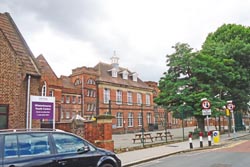
The Junior Schools at the Winterbourne Road Schools complex. The first site of the Open Air School was to the west of these buildings.
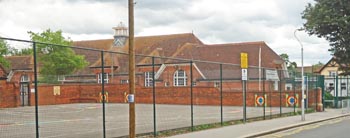
The Winterbourne Nursery and Infants School (above and below).
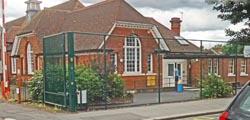
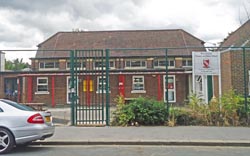
The extension to the Nursery and Infants School occupies the site of the Open Air School.
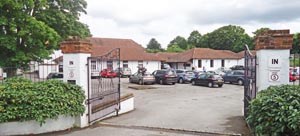
The second site of the Open Air School in Featherbed Lane now belongs to the Jehovah's Witnesses Church (above and below).
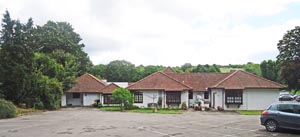
Rose GM 2004 St Giles Open-Air School, Croydon. Proceedings of the Croydon Natural History and Scientific Society 18 (no. 8).
http://staticlondon.gov.uk
http://wellcomelibrary.org (1)
http://wellcomelibrary.org (2)
Return to home page